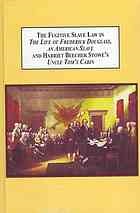GRAATOn-Line
Gender Studies & Cultural Studies. Estudios de género & Estudios culturales. Études sur le genre & Études culturelles.
GRAAT On-Line - Book Reviews
Gerardo Del Guercio, The Fugitive Slave Law in The Life of Frederick Douglass, an American Slave and Harriet Beecher Stowe’s Uncle Tom’s Cabin: American
Society Transforms Its Culture (Lewiston, N.Y.: The Edwin
Mellen Press, 2013). $49.95, 186 pages, ISBN 978-0773445185—Anne-Claire Lévy, Université Sorbonne Nouvelle-Paris III.
In The Fugitive Slave Law in The Life of Frederick Douglass, an American
Slave and Harriet Beecher Stowe’s Uncle Tom’s Cabin: American
Society Transforms Its Culture, Gerardo Del Guercio offers an
astute and in-depth examination of the implications of the Fugitive
Slave Law of 1850 and a fresh scholarly look at the impact that Frederick
Douglass’ 1845 Narrative and Harriet Beecher Stowe’s Uncle
Tom Cabin (1852) had on Antebellum America. Relying on the research
of leading twentieth and twenty-first century historians such as Henry
Louis Gates and Eric J. Sundquist, Del Guercio’s well-written
book explores the various ways in which two outstanding American writers
bore witness to the events of their age. The author, who has been
teaching English at the College Royal Military, St. Jean, Canada,
is specialized in nineteenth and twentieth century American literature.
The newness of his approach lies in his comparison of two works which
have up to now never been put into parallel by historians. Stowe is
a white American woman, Douglass is a black slave. Her work is a novel,
his is an autobiography. Despite their many differences both Douglass
and Beecher Stowe show that slavery existed because of the belief
in the inherently superiority of the white race. Whereas both works
challenge the morality of the Fugitive Slave Law and urge Americans
to break it not through violence but through words, Del Guercio contends
that they offer differing viewpoints on race and gender relations
not only to slavery but also to abolition.
Divided
into two parts and six chapters, this comparative study applies Garrisonian
abolitionist, Marxist and feminist perspectives to the two texts,
which allows the author to give a detailed look at the opinions of
the American people regarding the place of the slave in the antebellum
period. Through the lens of nineteenth-century race and gender ideology,
Gerardo Del Guercio focuses on the American north, domesticity and
emancipation. He contends that most American policymakers did not
care much about slavery in itself but aimed at preserving the Union
and American economy. He also and notably stresses that moral suasion
was an important abolitionist technique, that education and literacy
triggered resistance against civil government, and finally that both
race and gender played an important role in determining one’s
identity in Antebellum America. He throws light on his various arguments
by exploring the writings of leading nineteenth century political
thinkers, such as William Lloyd Garrison, Wendell Philips, William
Hosmer, and Henry David Thoreau, who just like Douglass and Stowe
did, participated in the restructuration of American ideology. Nineteenth-century
American slavery, Del Guercio claims, is actually what defines today’s
American race relations.
By
and large, The Fugitive Slave Law in The Life of Frederick Douglass,
an American Slave and Harriet Beecher Stowe’s Uncle Tom’s
Cabin: American Society Transforms Its Culture is remarkable
in a variety of respects. It is an illuminating and learned book that
addresses a large audience thanks to its clarity. It makes interesting
reading for those concerned with slavery, abolition, gender and race;
for professors, graduate students and advanced undergraduate students.
© 2013 Anne-Claire Lévy & GRAAT On-Line
